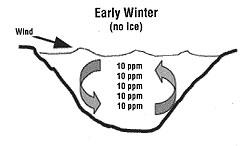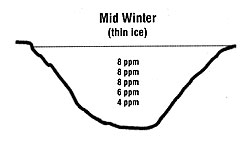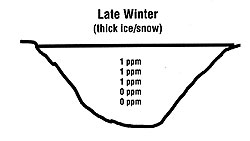Fish kills in Ohio ponds are rare events considering the large numbers of ponds and small lakes located in the state. However, they do occur every year, and some years are worse than others. Visiting your pond and seeing many dead fish floating around would no doubt cause you concern, particularly if the fish population is to your satisfaction. Fish kills can result from a variety of causes but the most common are weather, pond vegetation, and the interaction of the two. The critical parameter of these scenarios is oxygen level. Oxygen is essential to aquatic life and should be maintained at levels of 4 ppm (parts of oxygen per million parts of water = milligrams per liter of water) or higher. This fact sheet will focus on these three common causes and what you can do to minimize the possibility of a winter or summer fish kill in your pond. If you experience a fish kill and you suspect it is the result of disease or chemical spill, contact your county Extension Agent for assistance.
Winterkill
The Winter Oxygen Cycle
During winter, the contribution of oxygen from photosynthesis by green plants and algae is greatly reduced. This is caused by the normal fall die-off of plants and algae due to cold water. Additionally, those green plants that remain produce less oxygen because their metabolism slows in cold water. This does not mean that oxygen levels are much lower in winter. In fact, the reverse is true. In unfrozen ponds, high oxygen levels will occur during winter because the oxygen needs are less in cold water. Aquatic animal (primarily fish) metabolism and oxygen-consuming decomposition processes are greatly reduced in cold water. Also, cold water contains more oxygen than does the warm water of summer. The strong winter winds also keep the pond water circulating and continually add oxygen during winter. These factors combine to prevent winterkill in unfrozen ponds even though plants are contributing little oxygen during winter. Problems, if they are to occur, will happen once ice forms on the pond.
How Winterkill Occurs

Oxygen depletion scenario during winter ice cover. Oxygen levels are expressed as parts per million (ppm) and show generalized levels and trends.
Early Winter
Winterkill is the result of a significant decline in oxygen during a long period of ice cover. Figure 1 illustrates the sequence of events that can lead to winterkill. As long as the pond is open or partially open, oxygen levels remain high. This is because diffusion of oxygen from the air and wind agitation add more oxygen to the water than is used for animal metabolism and plant decomposition. This is even true for those very sheltered ponds that receive very little exposure to the wind.
Mid Winter
 When ice forms, neither wind nor diffusion from the air contribute oxygen to the water. The sole source of oxygen becomes the small amount produced by the few remaining algae and plants. If the ice remains thin and clear, oxygen production by plants and algae can continue as enough sunlight can filter through the ice to allow photosynthesis to occur. This production can nearly compensate for that which is used by respiration and decomposition that is continually ongoing. If the ice remains into mid-winter or thickens slightly, oxygen levels will begin to decline by 1-2 parts per million. This is because each day the pond plants and animals use slightly more oxygen than is produced. At this point, however, the pond still has sufficient oxygen.
When ice forms, neither wind nor diffusion from the air contribute oxygen to the water. The sole source of oxygen becomes the small amount produced by the few remaining algae and plants. If the ice remains thin and clear, oxygen production by plants and algae can continue as enough sunlight can filter through the ice to allow photosynthesis to occur. This production can nearly compensate for that which is used by respiration and decomposition that is continually ongoing. If the ice remains into mid-winter or thickens slightly, oxygen levels will begin to decline by 1-2 parts per million. This is because each day the pond plants and animals use slightly more oxygen than is produced. At this point, however, the pond still has sufficient oxygen.
Late Winter
 A serious problem develops when ice persists into late winter and thickens considerably or worse yet, is covered by snow. This reduces the amount of sunlight reaching the plants and algae, thereby substantially reducing the amount of oxygen produced. Since metabolism and decomposition continue unabated, oxygen levels begin to drop and can approach levels that threaten fish survival. In cold water, oxygen levels less than 2-3 ppm for an extended time will begin to kill fish. If levels drop to 1-2 ppm or lower throughout the pond, a complete fish kill will result.
A serious problem develops when ice persists into late winter and thickens considerably or worse yet, is covered by snow. This reduces the amount of sunlight reaching the plants and algae, thereby substantially reducing the amount of oxygen produced. Since metabolism and decomposition continue unabated, oxygen levels begin to drop and can approach levels that threaten fish survival. In cold water, oxygen levels less than 2-3 ppm for an extended time will begin to kill fish. If levels drop to 1-2 ppm or lower throughout the pond, a complete fish kill will result.
Factors Influencing the Likelihood of a Winterkill
Winter Severity—This is by far the most important factor in determining the likelihood of a winterkill. A mild winter means little or no ice and thus, no winterkill due to low oxygen levels. A harsh winter greatly increases the chances of problems. Ice thickness and clearness is important. As mentioned previously, thickening ice over time results in less and less light being available for photosynthesis. Perhaps the worst thing that can occur is for the snow to cover the ice. Often, winterkill is avoided as long as there is no snow cover (unless the ice is very thick which rarely occurs in Ohio). Four inches of wet snow on top of the ice nearly eliminates sunlight penetration and oxygen levels will decline quickly.
Pond Volume—The more water volume (i.e., gallons) in a pond, the less likely the pond will experience winterkill. This is why fish over-winter better in larger and/or deeper ponds. A one-acre pond that averages 6 feet deep will have more winter oxygen available than a one-acre pond that averages only 3 feet in depth.
Decomposition—An important factor is the amount of decaying organic matter that is present on the bottom. Dead aquatic vegetation and tree leaves account for most of the organic matter undergoing decay during winter. A pond bottom covered with these materials is more likely to experience winterkill than a pond lacking such materials. This is why ponds having a very dense aquatic plant community in summer are the very ponds most susceptible to winterkill during harsh winters.
Fish Biomass—The amount of fish (numbers and pounds) in the pond during winter also influences oxygen decline under the ice. Even though fish metabolism has slowed during winter, they still require oxygen. A pond that contains many pounds of fish will experience a faster decline in oxygen than a pond with fewer pounds of fish. This is why fish farmers closely monitor ponds in winter as they are maintaining fish biomass at levels that greatly exceed a normal pond.
Worst Case Scenario—Pond owners should be most concerned during a harsh winter in which ice cover persists, there is considerable snow cover on the ice, the pond is small and shallow, and the pond contained many aquatic plants the previous summer. Less ice and snow, fewer aquatic plants the previous summer, and the deeper the pond, the less likely a winter fish kill will occur.
Winterkill Prevention
Fortunately, winter fish kills can be prevented in most cases, due in part to weather conditions. Even in Ohio’s harsh winters, a warm spell can partially thaw a pond for a few days. Oxygen levels quickly rebound when a pond becomes ice-free. One timely warm period of 2-3 days can greatly reduce the possibility of a fish kill.
There are activities the pond owner can do to prevent a winterkill. The most important should occur during pond construction. Ponds should have shoreline slopes of 3:1 to limit the amount of shallow water where summer aquatic plant growth occurs. The reduced summer aquatic vegetation means less decomposition and results in higher oxygen levels under the ice in winter. Because deeper ponds experience winterkills less often, it is important to have a maximum depth of 10-12 feet if possible.
What can be done for the existing pond? Any strategy that limits the amount of plant decomposition that will occur during winter is important. There are a number of methods to eliminate or reduce summer aquatic vegetation that will decrease the amount of oxygen-consuming decomposition that occurs the following winter. Ohio State University Extension Fact Sheets A-3-98 Controlling Filamentous Algae in Ponds and A-4-98 Chemical Control of Aquatic Weeds along with the Ohio Pond Management bulletin describe a variety of strategies for controlling aquatic plants.
Another activity to be considered is the installation of an aeration system that helps keep a small area of the pond ice-free. Aeration not only adds oxygen to the water directly via the bubbles and agitation, but the open area allows for considerable diffusion of oxygen into the pond from the air. The aeration system does not need to be run continuously all winter. Rather, turn it on when ice is forming on the pond. Leave it off when the pond is ice-free. Aeration can be used sparingly in winter to minimize ice cover.
Safety note: Aeration during winter generally prevents safe ice from developing anywhere on the pond.
Finally, if your pond is ice-covered and aeration is not an option, fish winterkills can often be prevented by simply removing some of the snow off the ice. About 25-50% of the pond surface needs to be kept free of snow to maintain enough light to allow sufficient photosynthesis to occur. This is particularly effective in small, shallow ponds where the volume of water may not be sufficient to allow oxygen to last the winter.
Safety note: Only remove snow when the ice is safe. Four inches of ice is a good rule to follow before stepping onto the ice to remove snow.
William E. Lynch Jr.
Extension Associate, Aquatic Ecosystem Management
Eric R. Norland
Assistant Professor, Natural Resources
Extension Specialist, Natural Resources
